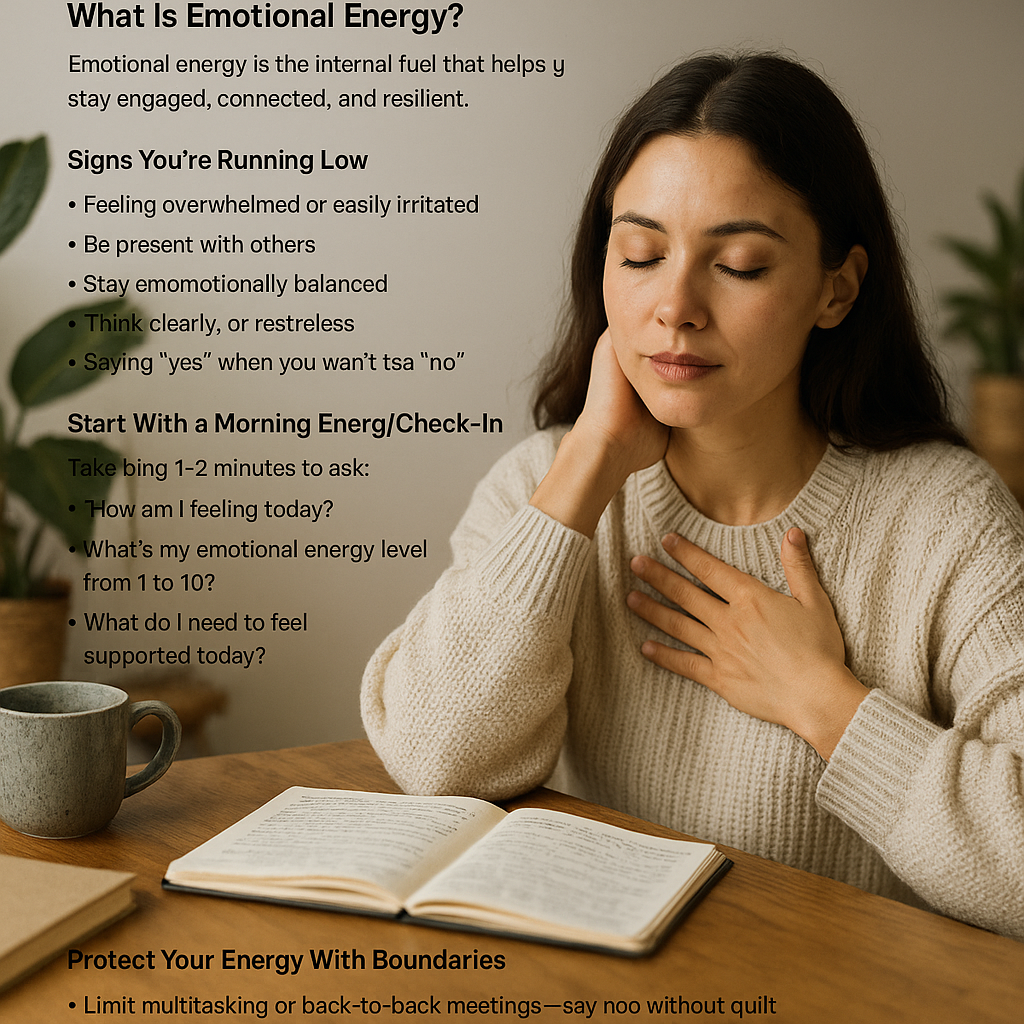Every day, you use energy — not just physical, but emotional. Conversations, decisions, stress, and even joy all require emotional investment. Yet, most people only manage their time, not their emotional energy. When emotional energy runs low, it’s harder to focus, stay patient, or feel motivated. The solution isn’t to push harder — it’s to manage and replenish your emotional reserves with intention.
What Is Emotional Energy?
Emotional energy is the internal fuel that helps you stay engaged, connected, and resilient. It allows you to:
- Navigate stress calmly
- Be present with others
- Stay emotionally balanced
- Think clearly and make decisions
- Recover from setbacks
Like physical energy, it fluctuates throughout the day and needs to be renewed.
Signs You’re Running Low
- Feeling overwhelmed or easily irritated
- Mentally foggy or emotionally numb
- Procrastinating or avoiding tasks
- Trouble concentrating
- Emotionally shutting down
- Saying “yes” when you want to say “no”
These are signals to pause and check in with your emotional reserves.
Start With a Morning Energy Check-In
Before jumping into your day, take 1–2 minutes to ask:
- “How am I feeling today?”
- “What’s my emotional energy level from 1 to 10?”
- “What do I need to feel supported today?”
This quick check-in builds emotional awareness and helps you plan your day more realistically.
Protect Your Energy With Boundaries
Not every request, message, or emotion is yours to carry. Set boundaries to preserve your energy:
- Limit multitasking or back-to-back meetings
- Say no without guilt
- Take breaks before you’re overwhelmed
- Avoid draining conversations when possible
Protecting your energy doesn’t make you selfish — it makes you sustainable.
Take Emotional Micro-Breaks
Just as your body needs rest, your emotions need recovery. Try:
- A few deep breaths every hour
- Stepping outside for 5 minutes
- Listening to calming music
- Putting your hand over your heart and simply breathing
These short resets help you release tension and come back to center.
Match Tasks to Your Energy Levels
If you’re emotionally low, it’s not the best time to make big decisions or have intense conversations. Instead:
- Use high-energy moments for deep work or social interaction
- Use low-energy moments for admin tasks, rest, or reflection
This creates flow instead of emotional strain.
Let Go of Energy Leaks
Notice what drains you unnecessarily. It could be:
- Trying to please everyone
- Overanalyzing small decisions
- Staying in conversations out of obligation
- Constant exposure to negative news or social media
Even small leaks add up. Seal them by simplifying, releasing, or stepping away when needed.
Refill With What Restores You
Make time every day to do something that restores your emotional energy. This could be:
- Laughing with a friend
- Journaling your thoughts
- Taking a quiet walk
- Reading something inspiring
- Creating art, cooking, or playing music
Refilling isn’t optional — it’s part of emotional maintenance.
Use the Power of Transition
Between tasks or emotional “chapters” in your day, take a pause. Before your next call, meal, or errand, breathe and reset. These transition moments help your system switch gears more smoothly and reduce emotional whiplash.
Final Thought: Energy Management Is Emotional Intelligence
You don’t have to wait until you crash to care for yourself. When you start managing your emotional energy like the valuable resource it is, you prevent burnout, increase joy, and improve every part of your day. It’s not about doing more — it’s about doing what matters, with clarity, care, and the energy to sustain it.
